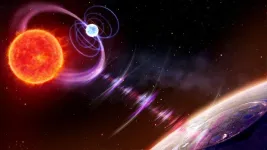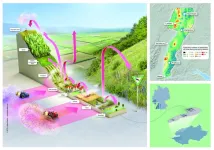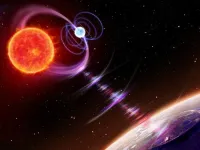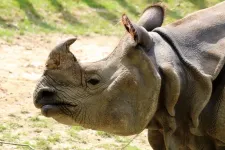(Press-News.org) Researchers have developed a new process for sustainable lithium extraction, which could help to address the growing global demand for the metals used in electric vehicle batteries and renewable energy storage.
Current ways of getting lithium are bad for the environment and more sustainable approaches are hard to perform on a large scale, but scientists have developed new membranes to pull lithium directly out of salty lake water using electricity, leaving other metal ions behind.
Publishing their findings in Nature Water today (12 Mar), the international group of researchers from the UK, France, and China reveal that the process offers a promising alternative to traditional lithium extraction methods.
Co-author Professor Melanie Britton, from the University of Birmingham, commented: “There is a critical demand for more-sustainable processes addressing the global challenges of mineral availability and clean water supply, which lead to a circular economy.
“We believe our findings could lead to more efficient and sustainable lithium extraction, which is crucial for the batteries powering everyday devices such as smartphones, laptops, and electric vehicles.”
The new filtration membranes enable direct lithium extraction from salt-lake brines through a selective electrodialysis process – efficiently separating lithium ions from other ions present in the brine.
Dr. Qilei Song, from Imperial College London who lead the work, commented: "Our research could reduce the environmental impact of lithium mining and contribute to the development of more efficient energy storage systems for renewable energy sources. There may also be applications in other areas of resource recovery – for example, critical metal recovery from wastewater, plastic and battery recycling.”
These novel filters can tell the difference between ions with one electrical charge (monovalent) and those with two charges (divalent) - making them very good at separating different types of salt ion.
The membranes use very tiny channels, smaller than a nanometer (a billionth of a meter) lined with special chemical groups that interact with the ions as they pass through. PhD student Louie Lovell in Prof Britton’s team applied pulsed field gradient nuclear magnetic resonance (PFG-NMR) technique to characterize the water and ion diffusion in the subnanometer channels in the membranes.
They found that the water diffusion co-efficients strongly depend on the channel sizes and the chemical groups within the membranes. These membranes can produce very pure lithium carbonate (Li2CO3), which is good enough quality to be used in batteries.
ENDS
For more information, please contact Tony Moran, International Communications Manager, University of Birmingham on +44 (0)782 783 2312 or t.moran@bham.ac.uk. For out-of-hours enquiries, please call +44 (0) 7789 921 165.
Notes to editor:
The University of Birmingham is ranked amongst the world’s top 100 universities institutions. Its work brings people from across the world to Birmingham, including researchers, teachers and more than 8,000 international students from over 150 countries.
‘Solution-processable polymer membranes with hydrophilic subnanometre pores for sustainable lithium extraction’ - Dingchang Yang, Yijie Yang, Toby Wong, Sunshine Iguodala, Anqi Wang, Louie Lovell, Fabrizia Foglia, Peter Fouquet, Charlotte Breakwell, Zhiyu Fan, Yanlin Wang, Melanie M. Britton, Daryl R. Williams, Nilay Shah, Tongwen Xu, Neil B. McKeown, Maria-Magdalena Titirici, Kim E. Jelfs, and Qilei Song is published in Nature Water.
Participating institutions: Imperial College London; University of Birmingham; University College London; University of Edinburgh; Institut Laue Langevin, Grenoble, France; and University of Science and Technology of China, Hefei.
END
New membrane discovery makes possible cleaner lithium extraction
2025-03-12
ELSE PRESS RELEASES FROM THIS DATE:
Entwined dwarf stars reveal their location thanks to repeated radio bursts
2025-03-12
An international team of astronomers led by Dr Iris de Ruiter, now at the University of Sydney, has shown that a white dwarf and a red dwarf star orbiting each other every two hours are emitting radio pulses.
Thanks to follow-up observations using optical and x-ray telescopes, the researchers were able to determine the origin of these pulses with certainty. The findings explain the source of such radio emissions found across the Milky Way galaxy for the first time.
The results are published in Nature Astronomy.
In recent years, better analysis techniques have given researchers the ability ...
Landscape scale pesticide pollution detected in the Upper Rhine region, from agricultural lowlands to remote areas
2025-03-12
A recent study by the RPTU University Kaiserslautern-Landau shows extensive pesticide contamination in the landscape of the Upper Rhine Region. The research team led by Carsten Brühl shows for the first time that synthetic chemical pesticides from conventional agriculture do not remain on the cultivated areas, but spread from the lowlands to the Black Forest and the Palatinate Forest. The results show that the entire landscape is contaminated with pesticide mixtures, shedding new light on the potential environmental ...
Decoding nanomaterial phase transitions with tiny drums
2025-03-12
When water freezes into ice or boils into vapour, its properties change dramatically at specific temperatures. These so-called phase transitions are fundamental to understanding materials. But how do such transitions behave in nanomaterials? In Nature Communications, a team of scientists led by TU Delft (The Netherlands) presents new insights into the complex nature of phase transitions in magnetic nanomaterials. Their findings reveal the coupling between magnetic and mechanical properties, paving the way for ultra-sensitive sensors.
The scientists from TU Delft, together with colleagues from the University of Valencia and the National University of Singapore, studied ...
Two-star system explains unusual astrophysical phenomenon
2025-03-12
(Images available via the links in the Notes section) An international team of astrophysicists led by the Netherlands and the UK have discovered that radio pulses lasting seconds to minutes are due to two stars coming together – rather than emissions from a single star. The results are published today (12 March) in Nature Astronomy.
In recent years, a new astronomical phenomenon has puzzled radio astronomers: researchers have detected radio pulses from the Milky Way that last from seconds to minutes. These pulses are unlike anything expected from known radio-emitting neutron stars, or pulsars*, ...
Minimal TV viewing may be protective for heart diseases linked to Type 2 diabetes
2025-03-12
Research Highlights:
A sedentary lifestyle such as watching TV (two or more hours daily) may be a key factor in the risk of developing heart and blood vessel diseases, according to an analysis of health records from a large U.K. biomedical database.
People with higher genetic risk for Type 2 diabetes may be more likely to have a heart attack, stroke or other types of atherosclerotic cardiovascular disease. However, limiting TV watching to no more than one hour a day may help offset the increased risk of these ...
Mass General Brigham study finds relationship between doomsday clock and patterns of mortality and mental health in the united states
2025-03-12
Results indicate the closer the Doomsday Clock ticks to midnight, the higher the rates are for mortality specific to Alzheimer’s disease, suicide, unintentional injuries, alcohol and substance-related disorders
Since 1947, the Bulletin of the Atomic Scientists (BAS) has used the metaphor of the Doomsday Clock as a means of communicating how close the human species is to self-imposed annihilation, represented as midnight. While early iterations of the clock focused more exclusively on the dangers of nuclear weapons, the BAS has also begun to consider other evolving existential dangers ...
Signs of ‘tipping point’ to electric vehicles in UK used car market
2025-03-12
Second-hand electric cars may be close to a “tipping point” where they become more popular than equivalent petrol and diesel cars in the UK, new research shows.
Researchers analysed data from car sales website Auto Trader, comparing daily views of adverts for electric vehicles (EVs) with petrol/diesel cars.
Interest in second-hand EVs grew rapidly, doubling from 3.5% of advert views in 2022 to 7% in 2023.
Importantly, interest in EVs became more “sticky”. Events such as petrol price increases drove extra EV views – and over time these spikes of attention lasted longer and longer.
“To identify ...
A new name for one of the world's rarest rhinoceroses
2025-03-12
A new study revealed significant differences in the appearance and behaviour of the two one-horned Asiatic rhinoceros species, challenging long-standing classifications and supporting a re-evaluation of their status.
The study, led by zoologist Francesco Nardelli and paleontologist Kurt Heißig, highlights how millions of years of evolutionary pressures have shaped the distinct adaptations of the Indian (Rhinoceros unicornis) and Sundaic (Rhinoceros sondaicus) rhinoceroses. The critically endangered Sundaic rhinoceros has a slender skull, a broader and lower back of the head, and a shorter nose and teeth suited for browsing leaves. In contrast, the ...
Why do children use loopholes? New research explains the development of intentional misunderstandings in children
2025-03-12
Most people are familiar with loopholes. When your boss, landlord, partner, customer, or government asks you to do something you don’t want to do, and yet you can’t say “no,” you may resort to malicious compliance – doing what someone asked, but not actually what they meant. Most parents are probably familiar with such “little lawyer” behavior too: if a parent says, “Time to put the tablet down,” a child might physically put the tablet down on the table – and then keep playing on it. While such ...
How satisfied are you with your mattress? New research survey aims to find out
2025-03-12
Sleep quality is a crucial aspect of health, yet while adults spend around a third of their lives sleeping, there is surprisingly little research on mattresses. Mass General Brigham researchers developed and tested the Boston Mattress Satisfaction Questionnaire (BMSQ), a new tool to rigorously assess mattress satisfaction and characteristics.
They administered the BMSQ to a representative sample of over 1,000 adults in the United States, finding that the tool is internally consistent and viable for assessing mattress ...




